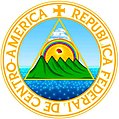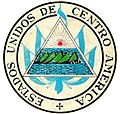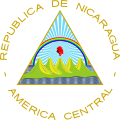Nicaraguan coat of arms
The Shield of Nicaragua was created, along with the current Nicaraguan Flag, by Legislative Decree of September 5, 1908, being President of the Republic José Santos Zelaya, definitively setting the Current Coat of Arms and Flag of Nicaragua. It is based on the Shield that belonged to the United Provinces of Central America.
Composition
It consists of two elements, the central and the peripheral, the first being an equilateral triangle of gold that represents the equality and rectitude of the Homeland and its institutions.
At the bottom, a mountain range of five yellowish-green volcanoes, between two ultramarine blue oceans, represent the unity and fraternity of the five Central American republics, just like the volcanoes and mountain ranges of the country.
The seas represent the Caribbean Sea and the Pacific Ocean that bathe the east and west coasts of the country respectively.
A vermilion red Phrygian cap illuminates the scene with white rays of light, from the central part of the triangle, representing freedom, against a background of a pale blue sky that symbolizes glory, heroism and sacrifice for freedom.
A rainbow with seven stripes that covers the mountains, below which is said hat, represents peace and the path by which Central America is going towards the achievement of its lofty destiny.
Around the triangle the peripheral element formed by the legend in gold letters: "República de Nicaragua - América Central"; the circular figure that forms the legend or emblem symbolizes heaven, perfection and eternity. At the same time, it indicates the unity of the interior elements of the shield and the gold of the letters and the edge of the triangle symbolize the mineral wealth of the country.
This shield is similar to the Shield of El Salvador, with the differences that the Salvadoran Shield has 5 flags behind the triangle, the laurel wreath around it and below the motto Dios - Unión - Libertad.
Previous Flags and Shields
From 1823 to 1838
Nicaragua, as part of the United Provinces of Central America, adopted the flag and coat of arms approved by the National Constituent Assembly of Central America, according to Decree No. 29 of [August 21], 1823. The Flag of the United Provinces of Central America, consisted of three horizontal stripes: blue at the top and bottom, and white at the center.
During the federal period, each State was free to modify the coat of arms of the United Provinces of Central America. Nicaragua reformed it by adding cannons and rifles at the foot of the equilateral triangle and a spear to support the Phrygian cap.
Nicaragua separated from the Central American Federation on April 30, 1838, the blue and white flag and the modified coat of arms continued to be used until the National Representation of Central America formed by the States of Nicaragua, Honduras and El Salvador decreed new insignia on April 22, 1851.
From 1851 to 1853
On November 8, 1849, the States of Nicaragua, El Salvador and Honduras agreed on a Pact of Confederation in the city of León, which should be settled by means of a Diet. The national representation of Central America was installed only on January 9, 1851, in Chinandega, made up of Pablo Buitrago Benavente and Hermenegildo Zepeda Fernández for Nicaragua, José Guerrero for Honduras, Francisco Barrundia and José Silva for El Salvador. The board of directors was immediately organized, with Mr. Hermenegildo Zepeda Fernández being named president, Mr. José Silva as First Secretary and Mr. Pablo Buitrago Benavente as Second Secretary.
On April 22, 1851, the National Representation of Central America declared the blue and white flag and the shield of the Central American Confederation mandatory; the latter would be an equilateral triangle; At its base would appear a mountain range of three volcanoes placed on a land bathed by both seas; at the vertex the rainbow that covers them and under it the hat of Liberty diffusing lights, and with three stars on top. Around the triangle and in a circular figure will be written in gold letters, "FEDERACIÓN DE CENTROAMÉRICA".
In 1854
On May 16, 1853, Don Fruto Chamorro Pérez, as Supreme Director of the State of Nicaragua, convened a National Constituent Assembly. After some difficulties in gathering those elected, it was inaugurated in Managua on January 22, 1854. One of the first provisions taken by the Assembly was to decree on February 28 of the same year that the State of Nicaragua would be called a Republic and the ruler would bear the title of president to hold office for a period of four years.
The Assembly attributed powers to elect the president in the first period from March 1, 1855 to 1859, choosing General Fruto Chamorro Pérez, remaining as provisional president while the legal period began. The new Republic issued a law creating the change of color of the flag, which should be yellow, white and mother-of-pearl, according to legislative decree; As for the shield, five volcanoes would no longer appear, but only one.
It is not known for how long these emblems were used, since the country adopted the banners for the second time in 1823, which it kept until 1908.
From 1893 to 1898
When General José Santos Zelaya assumed the presidency of the republic on September 16, 1893, he promised to work for the reappearance of the Central American Homeland; since Nicaragua was a disintegrated portion of the Republic of Central America. General Zelaya took advantage of the friendship with the presidents of Honduras and El Salvador, Dr. Policarpo Bonilla and General Rafael Antonio Gutiérrez, to promote the union of the three republics, because the presidents of Costa Rica and Guatemala showed no interest in said union.
On June 20, 1895, the plenipotentiaries of Nicaragua, El Salvador and Honduras, doctors Don Manuel Coronel Matus, Don Jacinto Castellanos and Don Constantino Fiallos, signed in the port of Amapala, Honduras the Treaty of Union that is known by the name of “Amapala Pact”; which establishes the Republics of Nicaragua, El Salvador and Honduras in a single political entity for the exercise of their sovereignty under the name of the Greater Republic of Central America. This denomination will persist until the Republics of Guatemala and Costa Rica voluntarily accept this agreement, in which case it will be called the Republic of Central America. In article number eleven of said agreement, the flag and coat of arms of the old federation are adopted, varying only the currency or legend.
On August 3, 1895, the Treaty of Amapala was ratified by the President of the Republic, thus officially including Nicaragua within the Greater Republic of Central America. After the ratification of the treaty by the three aforementioned governments, the Diet of the Greater Republic of Central America was installed in San Salvador. The Constituent Congress met in the city of Managua on August 27, 1898, and approved the Constitution of the United States of Central America. Shortly after the union came to an end due to the coup d'état by General Tomás Regalado (1898-1903), who deposed the President of El Salvador, General Rafael Antonio Gutiérrez, on November 13, 1898, and immediately declared the separation of this country; breaking the pact signed in Amapala and finalizing the ideal of Central American unity of General José Santos Zelaya.
Creating Decree of the current Flag and Shield
President General Zelaya, devoted to the cause of the Central American Union, wanted Nicaragua to once again use the flag and shield of the United Provinces of Central America, with slight variations, and on September 5, 1908 he signed the following Legislative Decree. Unfortunately, the transcribed Decree did not indicate the size of the Nicaraguan flag, since in the following years and decades the flag was capriciously given any size, since there was no official size. The blue stripes were made of any shade of blue and the shield did not adhere to the specifications that the Decree clearly explains, since they put a laurel wreath on it, flags behind the triangle (as the Shield of El Salvador has), the cap of freedom or Phrygian cap was put on a pole, the five volcanoes were not made the same size and were painted in any shade of green. It was not until 1971, 63 years after its creation, that the sizes and colors of the flag and shield were regulated, along with the National Anthem, Salve a ti.
Law on Characteristics and Use of National Symbols
On Friday, August 27, 1971, while Anastasio Somoza Debayle was President of the Republic, Legislative Decree No. 1908 "Law on Characteristics and Use of Patriotic Symbols", which specifies the use of the National Shield: the five volcanoes are yellowish green; the sky where the rainbow is is pale blue; the Phrygian cap is vermilion red; the seas are ultramarine blue and the capital letters, of equal size, are metallic gold.
Amendment of said Law
This Law was amended by Law no. 433 of July 2, 2002, published in La Gaceta no. the National Assembly the ex-president Doctor Arnoldo Alemán Lacayo a few months after handing over power to Bolaños.
Controversy over the use of this Symbol by the Government of President Daniel Ortega
At the end of January 2007, shortly after President Daniel Ortega Saavedra took office on the 10th of the same month, a psychedelic shield that simulates to the National Shield, but suppresses the legend that surrounds it, the left line is longer than the others and above it is the campaign slogan of the ruling Sandinista National Liberation Front (FSLN) party "United Nicaragua triumphs", instead of the legend "Republic of Nicaragua - Central America". The first official reaction was that of the Minister of Education, Miguel de Castilla Urbina, who declared that it was not the shield of the nation, but rather a metaphor: “There is no change of shield, they are two different things. I don't see the national emblem in that, because ours does not have red volcanoes, it is green, yellow and light blue. What I see is a metaphor of happy colors, I like it, also I don't feel that the country is being hurt, ”he said.
De Castilla stated that the logo came from the Ministry of Communication and Citizenship, which is coordinated by First Lady Rosario Murillo. "This logo will be used as the official logo in government instances," said the Minister of Education. This caused controversy among the opposition parties, especially in the Nicaraguan Liberal Alliance (ALN).
Historical shields
Contenido relacionado
Black metal
First punic war
Day of the pit of Toledo













